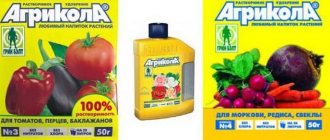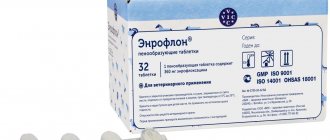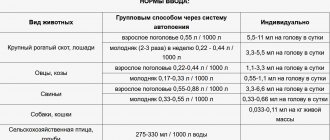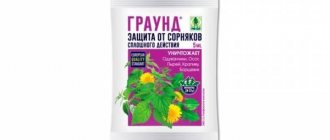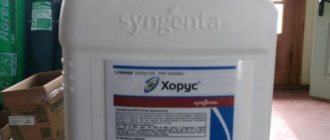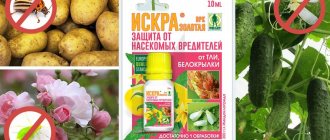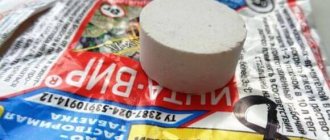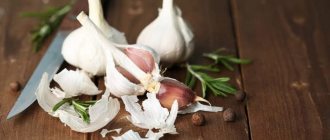Description of the antibiotic
Furazolidone belongs to the group of nitrofurans.
The drug is active against most types of bacteria. Nitrofurans disrupt cell respiration, reduce the rate of nucleic acid biosynthesis and completely stop it. As a result, cell destruction occurs. The drugs are used to treat intestinal diseases, giardiasis, trichomoniasis, and fungal infections. The composition of "Furazolidone" includes the following elements: "Furazolidone" is produced in tablets or in powder form. 1 tablet contains 50 mg of active substance; total weight 0.05 g. Tablets are packaged in contour cells of 10 pcs. A pack contains 1-4 plates with contour cells. 50 tablets are packaged in jars made from polymer.
The powder has a light yellow color. It does not dissolve in water. 1 g of the drug contains 0.98 mg of active substance. The powder is packaged in double plastic bags or in packaging made of metallized film. Package weight from 100 g to 1 kg. In veterinary medicine, “Furazolidone” powder is more often used for large livestock. In small farmsteads, the drug is purchased in tablets.
Furazolidone is stored both in tablets and powder in a dark place. The optimal temperature is 5-25 C. Use the product within 8 years after the date of manufacture. If the medicine has already been used, the package has been opened, then it should be hermetically sealed with film and protected from moisture.
In what cases should it be used?
Furazolidone is used for all farm animals and birds. For turkeys, it is chosen for preventive purposes and for the treatment of the following diseases:
- coccidiosis; the bird loses its appetite; her feathers fall out; diarrhea develops; droppings with foam and blood; individuals sit, ruffled; are not active;
- pullorosis; Turkeys have impaired coordination of movement; there is a malfunction of the respiratory system; birds breathe with their beaks open; diarrhea; there are disturbances in the functioning of the liver and gall bladder;
- giardiasis; disruption of the gastrointestinal tract; diarrhea with greenish-brown discharge;
- trichomoniasis; the bird loses interest in food; the functions of the digestive and respiratory systems are disrupted; severe intoxication of the body;
- syngamosis; parasites, syngamus, affect the trachea; they accumulate in the bronchi and lungs of turkeys; they have difficulty breathing; carry out complex treatment using an antibiotic and heating with an infrared radiation lamp;
- stomach dyspepsia; individuals lose activity; droppings have a putrid odor; foamy discharge with a yellow-brown tint; it is necessary to give an antimicrobial agent;
- colibacillosis; the livestock is very thirsty; joints become inflamed in turkeys; the bird falls to its feet;
- salmonellosis; tearing, purulent mucus is released from the nose, which clogs the airways; foamy droppings mixed with blood; the birds are lethargic and fall to their feet; they have muscle weakness.
Birds are treated for infectious diseases if this is justified. Most often, livestock are rejected. Furazolidone is given to turkeys whose reproductive functions are impaired: the egg is not formed correctly, inflammation of the oviduct is diagnosed.
Laying hens are administered the drug several months before the start of egg production as a preventive measure. Turkey poults are given antibiotics to prevent infectious, viral and helminth diseases. When using Furazolidone, accelerated weight gain is observed in young animals.
The medicine is used for open injuries. This is especially true in winter, when pecking is observed in the herd. Affected individuals are transplanted into separate cages, the wounds are treated with an antiseptic and the drug is applied in powder form. You need to know how to give Furazolidone to turkeys in order to avoid negative effects in the body.
Metronidazole for turkey poults for prevention: instructions
Poultry meat should not only be tasty, but also necessarily healthy. All pets suffer from one illness or another. Infections in the body of birds can have a bad effect not only on their growth and development, but also on the body of the person who has eaten their meat.
Bacteria and infections enter the animal’s body through food, feed, water, and through infection from other birds.
Parasites can infect the entire body and spread to others, infecting healthy individuals. To minimize such risks, you need to take a responsible approach to the issue of prevention or treatment using one of the best anti-infectious agents. Most infectious diseases of birds are eliminated with metronidazole.
The instructions say that treatment with metronidazole helps to cope with diseases such as:
- Histomoniasis – weakness, emaciation, weight loss.
- Coccidiosis is a disease caused by single-celled parasitic viruses.
- Trichomoniasis is an inflammation of the urinary system.
Signs and symptoms of one of these categories of illnesses may include:
Metronidazole has an antibactericidal effect and affects negative cells in the bird's body. It is used not only for treatment, but also to prevent the first symptoms of disease, that is, as a prophylactic agent.
Together with metronidazole, it contains a group of specific components that kill infectious sources of the disease and their carriers. There are many ailments within the scope of the medicine’s action, but it cannot fight certain types of mushrooms and spores. It is eliminated from the body naturally, within 5 hours - 2 days, and does not have a bad effect on other organs and their vital functions.
Description of the drug
The product is used to prevent many diseases not only in birds, but also in cattle. The active substance actively fights parasites, providing quick help for infections of various types. "Metronidazole" for turkey poults works at the cellular level. Its goal is to defeat harmful cells. Once in the body, it quickly penetrates the cell structure, reacts with DNA and destroys microorganisms without affecting healthy compounds. In other words, the medicine destroys the vital functions of bacteria, division, metabolism, etc.
The drug is based on synthetic protein from anaerobic creatures. Metronidazole will help rid turkey poults of the simplest forms. It is not an antibiotic, but rather a bactericidal agent. It disinfects the body by eliminating various bacteria, including those that reproduce by spores. The drug accumulates in tissues over time, especially in the liver. Therefore, delaying treatment is not recommended.
The form of release of the medicine may be different. Veterinary pharmacies have slabs or jars of white capsules, as well as powdered options. The product has a characteristic odor
The dosage per tablet can be either 25 mg or 125 mg, which is very important when choosing a course of treatment. Only by observing the grammage can a bird be cured
How to enhance the effect of the drug
It should be noted that without proper compliance with sanitary and hygienic requirements, no antibiotics, including Metronidazole, will give a positive result. In addition to regular cleaning and disinfection of the premises in which the livestock is kept, the correct selection of diet and feeding regime for birds, as well as temperature conditions, is necessary.
Other important care conditions include the following:
- newborn chicks should be kept exclusively warm, the ideal daytime temperature for them is 25–27°C, and at night these indicators rise by 2–3 degrees;
- whenever possible, it is necessary to limit the contact of turkey poults with representatives of other species of birds, especially if they have already suffered from any disease;
- young animals must be kept separately from adults;
- a bird with the slightest hint of illness should be immediately isolated and examined for the presence of a suspected disease;
- It would also be a good idea to take care of the prevention of other, no less unpleasant ailments of turkey poults, for example, diarrhea. For yellow diarrhea, it will be effective to use a drug with Levomycetin; you should definitely consult a doctor about the dosage;
- avoid crowding of birds - the room should be spacious, well ventilated and preferably sunny;
- bedding must be clean and changed periodically.
Did you know? Turkey poults need a total of about 16 hours a day to rest: during the day their continuous rest should be at least two hours four times a day, and at night
—
9 hours of sleep.
What diseases does metronidazole treat?
Metronidazole is a light-colored powder. This antibiotic is widely used to prevent diseases caused by parasites and microorganisms. The drug is of synthetic origin. Its actions are based on the fact that when taken orally, harmful microorganisms are destroyed.
Healthy organs and cells are not harmed and the birds are not harmed. The disadvantage that should be taken into account when taking metronidazole is that the substance accumulates in the blood of birds. Also, during laboratory studies, it was noticed that the drug accumulates toxic substances in the liver.
However, when prescribing, do not forget to give turkeys a large amount of water. This prevents the penetration and accumulation of metronidazole in the circulatory and nervous system. With its help, the drug is quickly removed from the blood through urine and feces.
The medicine helps with many known diseases. We list some of them below.
- Histomoniasis is an acute infectious disease. As a result of histomoniasis in turkeys, internal organs are affected, the liver being the most affected. With histomonosis in turkeys, the functioning of the digestive system is disrupted. In advanced cases, the cecum becomes inflamed. Most often, in turkeys, you can observe diarrhea of a greenish tint, with copious foam. Sometimes bluish plumage appears on the head.
- Sinusitis is a fairly common disease of the upper respiratory tract. Sinusitis in turkeys most often occurs during the onset of cold weather - in the autumn-winter period of the year. Characteristic signs of the disease are swelling of the mucous membrane of the eye and their redness. The disease is accompanied by dysfunction of the visual organs. In advanced cases, complete or partial loss of vision is even possible. The bird ceases to freely navigate in space. If the disease is not treated, over time the bird will have difficulty finding its way to the feeder. With sinusitis, general weakness and lethargy are usually observed. Farmers note that turkeys refuse food and do not go out for walking. Characteristic signs are heavy discharge from the eyes and nasal area. In this case, bumps with purulent discharge appear on the head, in the upper area.
- Tuberculosis is a disease caused by the viral bacterium tuberculosis bacillus. Sources of infection can be infected animals, contaminated water and food that contains the stick. Tuberculosis can also be contracted through nursery bedding and feeders. Symptoms of the disease include aching joints. With tuberculosis, general tone worsens. The bird refuses to eat, practically stops moving and neglects walking. The liver of a sick bird becomes enlarged and becomes covered with white spots. This becomes noticeable only when cutting up the carcass. It is prohibited to eat the meat of a sick bird.
YouTube responded with an error: Daily Limit Exceeded. The quota will be reset at midnight Pacific Time (PT). You may monitor your quota usage and adjust limits in the API Console: https://console.developers.google.com/apis/api/youtube.googleapis.com/quotas?project=210935582546
How is Metronidazole used for turkey poults?
Today, farmed poultry in rural areas is far from uncommon; in addition to the fact that turkey poults are raised for economic purposes, their meat is highly valued not only in the countryside, but also in expensive restaurants in big cities. But only a healthy bird will produce a quality product. Therefore, farms raising birds should know what metronidazole is for turkey poults, dosage, application and spectrum of action.
Use of Metronidazole for turkey poults
Side effects and contraindications
In clinical studies of the drug, virtually no side effects were identified. On rare occasions the bird has vomited. There is such a factor as individual intolerance to the drug. An allergic reaction appears as red spots. If you take the medicine for too long, you can provoke a fungus. The dosage of Metronidazole for turkey poults is slightly higher than for other poultry. If the owner does not see the result of treatment, then the cause is not bacteria.
It is not recommended to increase the ratio of the substance on your own. If Metronidazole is not suitable for the animal, then replace it with an analogue. Pharmacists in pharmacies recommend products with a similar effect, but with a different composition. Raising turkey poults for meat sales requires compliance with certain rules. Five days before slaughter, the medicine must be excluded from the bird’s diet.
Possible side effects
After taking the drug, turkey poults experience almost no side effects. Sometimes Metronidazole causes loss of appetite or allergic reactions. In some cases, bursts of excitability are observed.
Long-term use of the medicine is fraught with the risk of fungus. This is due to a violation of the microflora and the development of the inflammatory process of the mucous membranes.
The need for soldering
There are bottlenecks in the technology of raising young farm animals - the adaptation of the young to the conditions of the external environment.
Man has adapted the bird breeds he bred to suit his needs to such an extent that they have lost the ability to protect themselves from the surrounding microflora by their own means. The rapid growth rate is accompanied by a significant increase in the need for biological catalysts - vitamins. The conditions for keeping a large number of turkeys in a limited area make their own adjustments. The microclimate of the premises may differ from the comfort provided by the hen. Therefore, there is a need for artificial protection of growing chicks from harmful environmental factors.
recommended articles:
Starter feeds have been developed for different types of sex and age communities, which include all the necessary components to prevent the death of chicks from infections and vitamin deficiency. However, the high cost of food can make turkey farming unprofitable. Therefore, to prevent diseases, it is advisable to feed young animals with vitamins and antimicrobial drugs.
Feeding turkey poults with active biological agents has undoubted advantages:
- Low labor intensity.
- All livestock are subject to treatment.
- Sick chicks may refuse to eat, but they will always drink.
- Biological stimulants from an aqueous solution are absorbed better than from feed components.
Instructions for use for turkey poults
Keeping turkey poults requires high hygiene requirements for turkey poults - maintaining warmth, cleanliness and dryness, light conditions, and quality of feeding of turkey poults. However, even in good conditions, chicks are not immune from infectious infection.
Read about what to feed quails in this material.
The drug Metronidazole copes with such poultry diseases as:
These infections not only weaken the bird’s body, but can also infect humans who come into contact with meat products. Parasitic diseases are contagious, and if you do not want to lose your livestock, turkey poults must be treated with metronidazole prophylactically.
Read about Bronze North Caucasian turkeys in this article.
How to give and drink: dosages for turkeys
Turkey poults are given medicine from the first day and for the first 5 days. Metronidazole is usually added to the chicks' water bowl.
The instructions on how to water turkey poults are as follows:
- Feed the chicks a solution of Metronidazole, calculating the active substance at a dosage of 10 mg per kilogram of live weight of the bird 3 times a day.
- Add the medicine to the water or mash. Take 1.5 g of metronidazole powder per 1 kg of feed (or 3 g of drug powder per 5 liters of water) at a time.
The second method when treating turkey poults is used more often. Treatment lasts an average of 10 days. The dosage reaches in some cases 20 mg per 1 kg of weight, with a course of treatment of no more than 2-5 days. A repeated course of treatment, if necessary, is carried out no earlier than after maintaining an interval of 7-10 days.
Recommendations for use:
- Sometimes it is more effective to give the drug with food, since it does not dissolve well in water.
- Metronidazole tablets should be thoroughly ground into powder.
- To dissolve the drug, use boiled, settled water.
- For small chicks, the drug is instilled into the beak from a pipette.
How to solder for histomonosis
Histomoniasis is a dangerous disease of turkey poults that usually affects chicks from 20 days to three months of age. Histomoniasis rarely affects adult birds.
Signs of histomoniasis in turkey poults:
- decreased appetite;
- lethargy and inactivity;
- dirty and wrinkled feathers,
- drooping wings;
- yellow diarrhea;
- sometimes – blueness of the scalp.
Treatment is carried out in the following way: the drug is mixed with food.
The Metronidazole norm for turkey poults is 25 mg per kilogram of live weight. The drug must be given to chicks for 1 week.
Metronidazole is effective both for treatment and for preventing the first signs of the disease.
The dosage for disease prevention is slightly different: 20 mg per 1 kg of chick weight for 3-5 days.
In “tablet” equivalent, the dose will look like this:
- turkey poults from 20-25 days of age - 1/4 tablet of Metronidazole;
- from 45-50 days – ½ tablet,
- 70-75 days – 1 whole tablet.
- up to the age of 150 days, 1 tablet is given every 20 days.
Doses for coccidiosis
Coccidiosis is a disease that affects the digestive system of small chicks. Turkey poults become infected with coccidia through food. Parasites multiply quickly in the body and cause serious damage to the intestines and liver. The disease in chicks usually begins in an acute form. Symptoms of coccidiosis you should know:
- the chick refuses to eat;
- lethargy, drowsiness;
- diarrhea in turkey poults mixed with blood;
- dehydration, chicks drink frequently;
- the birds are freezing and gather in groups;
- feathers fall off and become ruffled;
- chicks fall, paralysis is observed.
Read about what to do if the legs of turkey poults move apart here.
To prevent the disease, the drug is given to turkey poults every 2 weeks for 5 days, until the age of 1.5 months. Drug dosage: 20-25 mg per 1 kg of bird weight.
How to drink with trichomoniasis
Trichomoniasis is a disease caused by flagellated protozoan microorganisms Trichomonas. Turkey poults 20–120 days of age become ill more often. Infection occurs through water and food. With trichomoniasis, the digestive system and liver of chicks are also affected. There is a decrease in weight and lethargy of the birds.
In adult turkeys, the disease occurs in a chronic form. It is not recommended to keep turkey poults together with adult birds to prevent infection.
The dosage of Metronidazole is calculated based on the weight of the bird: – 40 mg of medication per 1 kg of weight. The course of use for trichomoniasis is 2-5 days.
Metronidazole tablets for sinusitis
Sinusitis, or infectious runny nose, is an inflammation of the mucous membranes in turkey poults. The disease occurs at the age of 3 weeks. Provoking factors are dampness in the room, lack of vitamins for turkey poults from the first days A and D, overcrowding of birds, and lack of sunny walking.
- mucus leaking from the nasal openings;
- swelling under the eyes;
- weakened vision, chicks do not find food;
- weight loss.
The causative agents of the disease are transmitted with mucus through water, food, and bedding. The best means of control is prevention; in advanced cases, the drugs Farmazin, Tilan, and mechanical removal of pus from cavities are also used. It is advisable to separate sick chicks from healthy ones in a separate room, since they are carriers of bacteria even some time after treatment.
For tuberculosis
Unfortunately, there is no treatment for tuberculosis in turkeys. Having discovered a sick bird, it is slaughtered, the livestock is transferred to another room, and the poultry house is subjected to long-term ventilation or disinfection.
Read about brooders for turkey poults here.
What can you give with metronidazole?
The following folk remedies can be used together with metronidazole for prevention:
- include tobacco dust in the feed (1% of the weight of the feed),
- Give turkey poults less water, replacing it with fermented milk products: yogurt and whey. The intestinal microflora will then be less favorable for colonization by parasites,
- introduce finely chopped onions and garlic into the diet, 10 g per day per head,
- include chopped leaves of bird cherry, black currant, birch, but little by little,
- add finely chopped needles of coniferous trees, as they kill parasites and serve as a good source of vitamin C,
- Give a little bit of yarrow and wormwood every day.
Important! These methods and means do not need to be used all at once, 1-2 are enough, you can also alternate them. From the description above it is clear that metronidazole can and should be used primarily for the prevention of infectious infections
It is important to follow the correct dosage and, if possible, consult a veterinarian first.
From the description above it is clear that metronidazole can and should be used primarily for the prevention of infectious infections
It is important to follow the correct dosage and, if possible, consult a veterinarian first.
When to use
Can be prescribed to chickens, ducklings and goslings for therapeutic purposes. The dose of the product in this case will correspond to 25 - 50 mg per kilogram of live weight of the bird for 2 - 5 days. Turkeys need to use the drug in an amount of 20 mg per kilogram of scale for 2 days. Chickens will have to be treated again after 8 days.
How to use
Histomonosis is a disease of an infectious nature that affects organs such as the cecum, liver, and legs. The cause of the development of the disease may be poor quality disinfection of the poultry house before moving the livestock there. Characteristic signs are the appearance of diarrhea, which has a greenish or light orange color and a foamy consistency. As the disease develops, the chicks become lethargic, weak, and have dirty feathers. A sick baby falls to his feet, not having enough strength to get up.
For the product in the form of granules, the dose taken is 6 grams per 1 kg of feed. To prevent the disease, each chick aged 20 to 25 days should be given a quarter of a tablet of the drug. From the 45th day to the 50th day 0.5 is given, and from 71 to 75 - a whole tablet. Until day 150, for prevention, 1 tablet is required every 20 days.
Disease Prevention
In order not to give medications to every pet that falls on its feet in the future, it is better to take measures in advance to prevent the occurrence of dangerous infections.
The most important rule for keeping poultry is cleanliness.
Before moving the babies in, all surfaces of the poultry house should be treated with water and disinfectant solutions. After 3 days, general disinfection of the room and whitewashing is carried out using lime milk. Next, do not forget about regular disinfection of the poultry house and the equipment inside it. Bird food must be of high quality and fresh. It is forbidden to give moldy or spoiled food to your pets. It is dangerous to the health of your livestock, which may begin to weaken, squat on their legs, and so on.
To prevent babies from catching a cold, it is recommended to keep them warm and dry. If the chicks are huddled together, then the established temperature regime is not suitable for them. Young animals should be kept on a mesh floor with a mesh size of 1 by 1 cm or 1 by 2 cm. This way, the crumbs will not be able to peck the droppings at the same time as the fallen food. What will be the best prevention of the development of intestinal infections in them.
Video “How to put turkey chicks on their feet”
After watching this video, you will learn what to do if turkey poults fall on their feet and cannot get up.
Diarrhea in turkey poults is a common problem.
It is important to identify the disease in time, since in an advanced stage it leads to the death of individuals in 70% of cases.
If young animals huddle together for no reason, gravitate toward warmth, walk unsteadily, uncoordinated, and have a disheveled appearance #8212, these are the first symptoms of coccidiosis
It is enough for farm owners and breeders to always have antibiotics for turkey poults in order to prevent the development of the disease in time or carry out prophylaxis
Description of the drug Metronidazole
Metronidazole is an antiparasitic drug with a wide spectrum of antibacterial action. Having an adverse effect on parasites and anaerobic bacteria, the medicine is able to remove pathogens from the bird’s body naturally within 3 days. It also acts as a prophylactic agent that prevents the symptoms of the disease at an early stage.
Widely used to treat the following diseases common in poultry farming:
- histomoniasis - characterized by decreased productivity, refusal to eat, diarrhea, general weakness and sudden weight loss;
- coccidiosis is an infectious disease accompanied by exhaustion, immobility, modification of plumage and feces;
- Trichomonosis is a particularly dangerous disease, manifested by damage to the respiratory tract, which first makes it difficult to eat, and then to breathe, and as a result leads to suffocation.
It is produced synthetically and is sold in the form of tablets and white powder. The drug is effectively used as not only an internal, but also an external agent, for example, to disinfect wounds and damaged skin of turkeys.
Compound
Metronidazole tablets are mainly used to treat birds, less often an injection solution or powder. The tablets of the drug are cylindrical in shape and have a white or slightly greenish tint; each contains:
- active substance metronidazole - 250 g;
- additional substances: corn starch, microcrystalline cellulose, stearic acid, povidone, soapstone.
Release form
The medicine has been extremely popular since the Soviet era and has been successfully used to treat not only birds, but also people, therefore it is sold in a variety of forms, namely in the form of:
- tablets - 30 pieces per package;
- solutions for infusions - 1 bottle in a box;
- cream for external use - 30 g in a tube;
- candles - 7 pieces in one cell package;
- granulates - 0.5 g per plastic bag.
pharmachologic effect
Metronidazole is one of the drugs that have antibacterial and antiprotozoal effects; it is particularly effective against protozoan parasites and anaerobic microorganisms. After administration, it is able to destroy bacterial cells in the shortest possible time, without affecting healthy ones. The following microorganisms are most sensitive to antibiotics:
- dysentery amoeba;
- intestinal lamblia;
- Veillonella;
- Trichomonas;
- histomonas;
- gardnerella.
The antibiotic weakens the formation of cells of these microorganisms and prevents their synthesis, which subsequently leads to the death of the bacteria. Unfortunately, various fungal diseases and aerobic bacteria are absolutely not susceptible to the medicine. The active substance Metronidazole is characterized by the ability to accumulate in the liver, having previously penetrated there from the lymphatic system. The medicine is instantly absorbed and distributed in the organs and tissues of the bird.
It is completely excreted from the body within 72 hours along with excrement, which acquires a specific dark red color. The medicine has proven itself to be an effective treatment method, including for chicks, so timely therapy will provide good prevention for turkey poults, and healthy and productive livestock for farmers.
Pharmacological characteristics
Metronidazole is used to treat diseases of turkey poults. This medicine belongs to antibiotics and is included in the list of life-saving extended-spectrum medications.
- It has antiprotozoal and antimicrobial effects.
- It has a detrimental effect on pathogenic microorganisms, including a number of obligate anaerobic and some gram-positive and gram-negative bacteria.
- Effective against protozoa - infections caused by parasitic unicellular protozoa.
- Does not have a suppressive effect against pathogens of infectious diseases of fungal etiology.
The product is used not only orally, but also externally (when treating wounds and damaged skin).
Compound
It is of synthetic origin, being a derivative of the natural substance azomycin. The active element is metronidazole.
1 tablet with a total weight of 0.250 g contains 125 mg of the active ingredient.
Poorly soluble in water. When diluted in liquid, precipitation may occur.
Excipients include corn starch, microcrystalline cellulose, stearic acid, soapstone, povidone.
Release form
Available in powder, liquid and tablet form.
Acceptable forms of release:
- in tablets of 250, 1000 pieces;
- in bags of 0.25, 0.5 and 1.0 kg;
- in solutions for infusion of 100 ml.
Impact scheme
The mechanism of action lies in the interaction with the DNA of the cells of protozoan microorganisms and inhibition of the latter's synthesis of nucleic acids, which leads to a stop in the formation of the cellular structure and provokes their death.
When it enters a living organism, it destroys bacteria and microorganisms and inhibits their growth without damaging healthy cells.
Most susceptible to antibiotics:
- dysenteric amoeba;
- gardnerella;
- intestinal lamblia;
- histomonas;
- Veyonella;
- Trichomonas.
Penetrates and in a short period of time concentrates in the blood plasma (about 4% of the total share), distributes well in many tissues and biological fluids (bile, saliva, spinal cord, pleural fluid), accumulates in bone tissue and is metabolized by liver cells (up to 60%) . Actively absorbed from the gastrointestinal tract.
Metronidazole has an antiviral effect
Duration of elimination from the body is 2 days, incl. with urine - up to 80%, with droppings - up to 15%.
Compatibility with other medications
Compatible with other medications, with the exception of those belonging to the group of antibiotics.
Medical description
Metronidazole is a strong antiparasitic drug, so its independent use in animals is not advisable. To make an accurate diagnosis, it is recommended to consult a specialist.
A ban on the use of the drug can only be intolerance to its active substance, which happens very rarely. Regarding side effects, the occurrence of allergic reactions should be highlighted, but their risk is minimized if the recommended dosage of the medication is observed.
In veterinary medicine, metronidazole is offered in packs of 250 and 1000 tablets, but doctors can sell them individually. The dosage of the drug is 0.25 or 0.125 mg of the substance.
https://youtube.com/watch?v=_y235lM8asA
Composition and release form of the drug
"Metronidazole" is named after the active ingredient of the same name in the composition. 1 tablet weighing 0.25 grams contains 0.125 grams of the active ingredient. Cellulose, stearic acid, as well as corn starch and other elements are used as auxiliary preparations.
| Release form | Package | Quantity or weight (volume) |
| In tablets | Banks or contour cells | 250 or 1000 pcs. |
| Powder | Packages | 250, 500 and 1000 g |
| In solutions | Bottles | 100 ml |
Metronidazole, which has antimicrobial properties, is also used to treat scratches and other damage to the skin.
Schemes for feeding turkeys
There are three approaches to antibiotic administration. Some experts consider it advisable to introduce them immediately from the 1st day of life. They are guided by the idea of protecting the offspring from possible infections and rely on prevention.
Feeding turkey poults
Poultry farmers who refuse to use antibiotics on the first day believe that these drugs disrupt the natural maturation of the gastrointestinal tract of birds. The organism is born with a sterile intestinal environment. An antibiotic disrupts the proper formation of microflora in it and, ultimately, has a detrimental effect on the formation of one’s own immunity. These experts believe that in the first days of a bird’s life, emphasis should be placed on vitamin supplementation and a properly balanced diet. Antibiotics are given only on days 5-8 of life, when the body is stronger and the internal microflora is practically formed. At the moment, this scheme is the most common among poultry farmers.
There are poultry farmers who are opposed to the use of antibiotics for preventive purposes when raising chickens. Their use is allowed only in cases of urgent need at the onset of illness. As a rule, this approach is professed on eco-farms among apologists for a healthy lifestyle.
Organization of maintenance and soldering in the first days
Prices for a brooder - a cage for raising chickens
Brooder - a cage for raising chickens
It has been noted that mortality occurs most often on days 10-14 of the offspring’s life. Therefore, it is at this moment that it is necessary to complete the course of feeding the chicks. A number of poultry farmers also recommend reintroducing antibiotics during this period.
Additionally, to strengthen the body's defenses, iodine is added to the water in the amount of a few drops. During cold weather, dampness, and the height of respiratory diseases, it is recommended to give a solution of iodinol.
Iodinol
Basic scheme for feeding turkey poults
| Days | Drugs |
| 1 | solution with vitamins and 20 g of sugar (glucose) |
| 2-5 | administration of antibiotics |
| 5-8 | introduction of vitamin supplements |
| 14-15 | administration of drugs to prevent candidiasis |
Based on this scheme, poultry farmers have developed several types of soldering systems.
Method of organizing soldering in small farms
First soldering scheme
The regimen involves the introduction of antibiotics from the second day:
| Days | Drugs |
| 1 | 2 g vitamin complex and 20 g sugar |
| 2 | 0.5 g tetracycline in drink |
| 3-4 | 0.5 g tetracycline and levomecithin |
| 5-8 | adding a vitamin complex (Chiktonik, Nutril, etc.) |
| 14-15 | Baycox or Amprolium for the prevention of coxidosis |
Adult turkey
Second soldering scheme
| Days | Drugs |
| 1-5 | antibacterial drugs (antibiotics) |
| 6-15 | vitamin complexes |
| 18-22 | repeating a course of antibiotics |
With this scheme, a good option would be to administer enroxil. Its daily dose is no more than 10 ml per 1 kg of bird weight.
Enroxil
Third soldering scheme
| Days | Drugs |
| 1-7 | adding sugar (glucose) and vitamin complex |
| 8-11 | administration of antibiotics |
| 12-18 | introduction of vitamin supplements, probiotics |
Trivit can be recommended as a vitamin complex. Its dosage in this regimen is 1 ml once a day. Among probiotics, Vetom is effective. The latter can also be administered from day 1. Its administration protects against dysbiosis before and after a course of antibiotics.
From the age of one month, feeding begins for the prevention and control of infectious diseases. Here, antibiotics of general action such as trichopolum (metronidazole) or directed action against certain infections such as Baycox can be used.
Method of organizing watering in large poultry houses
Fourth soldering scheme
The scheme is based on periodically feeding the chicks with antibiotics.
| Days | Drugs |
| 1-5 | farmazin (baytril) morning and evening |
| 7-11 | vitamin complexes |
| 16-18 | vitamin complexes |
| 21-30 | half a tablet of metronidazole in 1 liter of water once a day |
| 33-34 | farmazin (baytril) morning and evening |
| 45-54 | half a tablet of metronidazole in 1 liter of water once a day |
| 58-59 | farmazin (baytril) morning and evening |
| 60-64 | vitamin complexes |
| 65-74 | half a tablet of metronidazole in 1 liter of water once a day |
| 140-141 | farmazin (baytril) morning and evening |
The poultry farmer can vary the scheme depending on the health of the flock. If there is no disease, the young are kept separately from the adults and do not have a common walk with other birds, then if they are feeling well, the chicks can be given metronidazole only in step 4.
Turkey family
Vetom is administered from day 1 according to the following scheme:
- 6-13 days;
- a weekly course every other month on a regular basis.
Or:
- 1-7 days;
- 37-41 days;
- 71-75 days.
How to give it to the smallest chicks
Oral use of the tablet is calculated in a slightly different amount:
- 25% tablets, where the active substance will be 0.125 g - per 6-6.5 kg of bird weight.
- The same consistency, but half a gram - for a weight of 12.5.
- A 1 gram tablet is designed for 20 kg of animal weight.
- 50% per 0.5 g - dosage is calculated for a weight of 25 kg.
If the tablets are used together with food, it is worth remembering that:
- If the food is granulated, you should give 6 g of the drug per 1 kg of food
- Accordingly, the tablets are 25%, where substances of 0.125 g are added in an amount of 24-25 pieces.
- Same consistency, but half a gram – 12 tablets
- The last 2 options are 6 units per 1 gram tablet, and 50 percent per 0.5 g tablet.
- On average, it is customary to give about 40 mg per 1 kg of bird weight in the form of a 0.1% solution. In this case, the course of treatment should not exceed a maximum of 5 days.
Prevention in birds
The optimal solution for every farmer is to protect turkeys from infection. To achieve this, basic preventive measures are taken. You need to purchase birds from trusted breeders, keep adults separately from young animals, etc.
Diet
The condition of the gastrointestinal tract depends on the food given to turkeys. The diet should consist of the following components in percentage terms:
- grain – 60-65%;
- feed yeast – 3-4%;
- herbaceous plants – 4-5%;
- limestone – 3-3.5%.
To balance the menu, chalk, dry food, sunflower cake, and fish meal are added.
You cannot buy food that has not been disinfected, as it contains various bacteria.
Vaccination
Thanks to timely vaccinations, the risk of infection of turkeys is significantly reduced. The mycoplasmosis vaccine is administered twice - 1 and 3 months after birth.
It is important to vaccinate against pseudoplague. For this purpose, products based on La Sota strains (paramyxovirus, which is the causative agent of Newcastle disease) are used.
Vaccinations are given on the following days after birth:
- at 14-20;
- at 35;
- at 60;
- at 120-125.
If this is not done in a timely manner, the farmer will lose his entire livestock.
Bird hygiene
The best conditions for the proliferation of pathogenic microorganisms are dirt, so you need to adhere to the main sanitary and hygienic rules for keeping birds:
- do not allow excess heat, as bacteria multiply in this environment;
- monitor the humidity level, regularly ventilate the house;
- change bedding at least once a day;
- install feeders outside the cages;
- Change drinking water twice a day or place drinking bowls with dispensers.
If turkeys experience diarrhea, it is important to determine the danger of liquid feces by color, isolate sick individuals, and take fecal samples for examination. This will help provide timely assistance to the birds. The sooner this is done, the less likely it is that other birds will become infected.
0
0
Copy link
Scope of application
Metronidazole is used for hatched turkey poults as a drug to combat histomoniasis.
The medicine is usually mixed with drink or birdseed. If your pets look completely healthy, you still need to regularly carry out preventive maintenance with this product. Metronidazole also demonstrates its high effectiveness in the treatment of trichomoniasis. With this diagnosis, you can give medicine both internally and locally. The size of the required dose is calculated directly from the weight of the chick. On average, the following dosage is used: 40 mg of the drug per 1 kg of chick weight. Duration of treatment is from two to five days.
Metronidazole for chickens against diarrhea
There are a number of diseases caused by parasites, one of the symptoms of which is diarrhea. To destroy them, metronidazole is often used - a fairly common drug that is effective in the fight against anaerobic bacteria and parasites.
It successfully copes with pathogens of diseases such as:
- trichomoniasis;
- coccidiosis;
- histomoniasis.
The listed ailments are dangerous due to their ability to affect the bird’s digestive tract, causing inflammation. In the absence of timely treatment, complete liver damage occurs, significant weight loss and death. Moreover, we are not talking about an individual individual, but about an entire population of poultry, which can cause serious economic damage to both a private farmstead and a large farm.
Signs of trichomoniasis:
- chickens become lethargic and lose activity;
- temperature rises;
- you can see a yellow coating in the bird’s throat;
- the goiter increases;
- there is yellow-gray diarrhea with a strong pungent odor;
- discharge appears from the eyes and nostrils;
- breathing becomes difficult.
Coccidiosis in chickens
Symptoms of coccidiosis:
- strong thirst;
- decreased appetite;
- fluffy, ruffled feathers;
- loss of activity;
- presence of diarrhea, sometimes mixed with blood;
- a feeling of chills, expressed in the chickens’ attempts to huddle together and keep warm.
Signs of histomoniasis:
- decreased activity, depressed state;
- blue discoloration of the skin on the head, especially noticeable in turkey poults;
- loss of appetite, in severe cases complete refusal of food;
- unkempt, disheveled appearance;
- yellow diarrhea with gas bubbles.
It is obvious that diarrhea affecting broiler chickens, as well as young animals of other poultry, is only a separate symptom of more serious diseases that require immediate treatment.
All of these diseases occur in unsanitary conditions when young poultry consume contaminated feed or water. Moreover, preventive measures must be started in the first days after the purchase of broiler chickens or the birth of birds.
Types of diarrhea in turkeys
The first thing you need to pay attention to when dealing with diarrhea in turkeys is the color of the droppings. By the shade you can understand what caused the diarrhea, how dangerous it is and how you can help the birds before going to the veterinary clinic.
Excrement samples are necessarily collected for laboratory testing, thereby determining the type of pathogen.
Yellow
More often than not, this shade of liquid masses is considered not dangerous. Most often caused by indigestion due to the inclusion of a new food or another type of feed in the diet. But you should not completely ignore yellow feces - this may be a sign of the development of a dangerous Newcastle disease.
In this case, not only diarrhea appears, but also other symptoms:
- apathy;
- decreased appetite;
- staggering;
- difficulty breathing;
- convulsions.
If these signs are not present, it is enough to give the birds a light pink solution of potassium permanganate.
Green
Green diarrhea always indicates an infectious infection of turkeys. These are the following pathologies:
- Coccidiosis. When the disease occurs, bloody spots in the stool, ruffled feathers, and lethargy are noted. As the feces develop, they become dark brown in color.
- Pasteurellosis. The peculiarity of the manifestation is the stringiness of feces, the presence of blood impurities and foam.
- Newcastle disease. Characterized by changes in gait, lack of appetite, and convulsions.
With such lesions, there is a risk of extinction of the livestock from 30 to 100%.
White
White stool is the most dangerous - it indicates paratyphoid fever and salmonellosis. The reason is the bacterial pathogen Salmonella, which is characterized by increased survivability (does not die even at low temperatures).
It is necessary to additionally treat the poultry house with disinfectants.
Mustard
Mustard-colored liquid feces are observed with such an invasive disease as histomoniasis. The causes of development are damage by protozoan parasites, which are localized in the cells of the liver and cecum.
The main signs of the disease:
- increased smelliness from feces;
- swelling;
- blue discoloration of the mucous membranes and skin of birds;
- a sharp decrease in body temperature;
- painful spasms (manifested by a plaintive squeak);
- constant trembling;
- disheveled;
- depressed state.
At the beginning of the development of histomoniasis, light yellow feces are observed, which then acquire a mustard tint.
The infection is spreading rapidly, so action must be taken immediately. For treatment, the veterinarian prescribes Metronidazole. Before going to the veterinary clinic, sick individuals are isolated and the poultry house is disinfected.
Brown
This is not a dangerous symptom. Brown feces occur when new foods are introduced to turkeys, such as eggs. Normal stool is dark brown in color, but with changes in diet, the stool becomes lighter in color.
To prevent this from happening, new foods should be introduced into the diet in the smallest dosages. This will allow the birds’ body to get used to it faster.
Black
Black feces indicate intoxication of the body. Birds can be poisoned by poisonous plants, spoiled foods, grains with microtoxins, low-quality or expired specialized food.
Blackness is caused by digested blood fluid and waste products of pathogenic microorganisms. Blood appears in the gastrointestinal tract due to internal bleeding during inflammatory processes.
Folk remedies
If it is not possible to call a veterinarian or buy the necessary medications, farmers use traditional medicine recipes, but the following measures must be taken before treatment:
- sick birds are selected and removed from the main flock;
- the habitat of infected individuals is thoroughly cleaned - the litter is changed, the room is disinfected;
- all the feed that was available at the time when the sick turkeys were in the common poultry house is replaced;
- to restore the digestive system, activated carbon is added to the feed;
- the amount of liquid the birds drink increases.
What products do turkey breeders recommend using:
- Rice porridge. Boil short-grain rice until it forms a thick consistency. Cool and feed to the bird 2-4 times a day.
- Green tea. The tincture should not be strong, so add 1 tsp to 1 liter of boiling water. green tea leaves, cool until warm, pour into a drinking bowl.
- Nettle decoction. For 1 liter of boiling water, take 7-8 tbsp. l. plants. Put on fire, after boiling, cook for 5-7 minutes. Cover with a lid and leave for 1-2 hours. Strain and give to sick individuals to drink.
- Chamomile tincture. Pour 0.5 liters of boiling water into a thermos, add 4 tbsp. l. herbs. Leave for 3 hours, filter. Add to drinking water until the liquid is light in color.
- Pomegranate peels. Prepare the crusts in advance when raising turkeys. To do this, peel the pomegranate and place it on paper in a dark, warm and dry place. When the peels are completely dry, put them (1 tsp) in a thermos and fill with boiling water (250 ml). Let it brew for 1-2 hours. Add water to birds at the rate of 1 liter of water.
How many times should the treatment be performed?
Typically, one 0.5 gram tablet contains 250 milligrams of metronidazole. If signs of disease are detected in turkeys, trichopolum should be given in certain doses, which depend on the weight of the bird. It can be used in two forms:
- give medication per kilogram of live weight,
- add the medicine to food during feeding or drinking water.
In the first case, the treatment dose is 10 milligrams of metronidazole powder per 1 kilogram of turkey weight (this is approximately 1 tablet per 10 kg). Trichopolum is given three times a day.
In the second option, the food is added to food or drink once: 1.5 grams of powder per 1 kilogram of food (or 6 tablets), for dissolution in drink - 3 grams of powder per 5 liters of water (equal to 12 tablets).
For chicks, the second method of using the drug is usually chosen.
Treatment is carried out for nine to ten days, subsequently moving to doses used for preventive purposes. In some cases, veterinarians prescribe 20 mg per 1 kilogram of turkey weight, reducing the duration of treatment to 2-5 days. If there is still a need for repeated treatment, then do this no earlier than seven to ten days later.
The main symptoms of diarrhea in turkeys
Normal turkey feces are dark brown in color and have a dense consistency that looks like oblong pellets. If the stool is liquid, it is considered diarrhea, which in turn is a symptom of pathological disorders in the digestive system.
Diarrhea leads to fluid loss (dehydration), so it is accompanied by the following symptoms:
- weakness and lethargy;
- increased frequency of bowel movements;
- loss of appetite;
- apathetic behavior of the bird;
- drooping wings;
- difficulty getting up on your paws;
- increased feeling of thirst;
- weight loss
As the disease progresses, birds spend more time sitting, cresting and closing their eyes. The plumage becomes dull, dirty lumps form near the cloaca, and feathers fall out. Conjunctivitis develops, the nasal passages and larynx become clogged with mucus, and convulsions begin.
If the entire herd gathers in one heap and the birds press against each other in an attempt to keep warm, this indicates the defeat of all individuals.
Metronidazole: instructions for use for turkey poults
It is easier to prevent any disease than to treat it later. Turkey poults will grow healthy only if the following conditions are met:
- maintaining the temperature in the poultry house according to age;
- regular cleaning and cleanliness of the poultry house, periodic change of wet litter to dry;
- correct light mode;
- compliance with area requirements per individual;
- high-quality feed from a trusted manufacturer;
- prophylactic drinking with metronidazole.
An option for tablet drinking for those who prefer not to weigh, but to calculate the dose approximately depending on age:
- turkey poults 3 weeks old - 1/4 of the tablet per turkey;
- 6 weeks of age - 0.5 tablets per turkey;
- 9 weeks of age - 1 tablet per turkey.
After a 5-day course and before reaching 5 months of age, 1 tablet per 1 individual is given for prevention purposes, once every 20 days.
Beginner poultry farmers often wonder: what is the dosage and methods of using metronidazole for turkey poults and how to properly water their pets?
Metronidazole (Trichopolum): step-by-step instructions for use for turkey poults for the purpose of prevention:
- First you need to correctly calculate the dose of medicine for the entire livestock. To do this, one medium-sized turkey is weighed. Its weight is multiplied by the number of turkey poults. The result obtained must be multiplied by the daily preventive dose for turkey poults of 25 mcg per 1 kg of live weight. In a live example, it will look like this: let’s say 0.5 kg is the weight of a turkey poult, which is multiplied by the number of all turkey poults, for example, 10 heads, the result is 5 kg. This weight is multiplied by the daily dose of 25 mcg and the result is 125 mcg. This amount of active substance is contained in one tablet, which means 1 tablet of metronidazole will be required for the entire livestock.
- Next, you need to dilute 1 tablet in 1 liter of water and pour it into the turkey poults’ drinking bowl in the morning. As soon as you drank, that’s it! This concludes the prevention. Next, you can only pour clean water into the drinking bowl.
- Repeat the procedure for 5 days in a row.
- Repeat preventive drinking in courses of 5 days every 2 weeks.
- Do not forget to re-calculate the dose depending on the results of weighing before each course.
Metronidazole or Trichopolum for turkey poults for prophylactic purposes is absolutely harmless and does not cause harm to health. On the contrary, the use and use of this drug will allow you to avoid a number of diseases that inevitably lead to a decrease in daily weight gain and even death.
Metronidazole very rarely produces side effects, and in rare cases an allergic reaction occurs. In this case, you need to consult a veterinarian who will select a different antibiotic.
Important! Slaughter of poultry for meat is permitted only 5 days after the end of use of the drug.
Treatment of adults
Sometimes, even after preventive measures at a young age, adult animals can get sick. Most often, such situations arise with waterfowl species. The use of metronidazole for adults is also allowed, but the dosage is already 1.5 g of the drug for each kg of live weight of the livestock. The duration of the course increases to 10 days.
A similar course of treatment can also be carried out as a prophylactic agent to obtain strong offspring from the existing livestock in the future. Eggs from treated birds can be eaten no earlier than 5 days after the last intake.
Direction of action
Metronidazole is used both in veterinary medicine and in conventional medicine to remove protozoan parasites and anaerobic microorganisms from the body. In the case of poultry, this remedy helps to cure and prevent diseases such as:
- histomoniasis;
- coccidiosis;
- trichomoniasis.
The instructions for use must include information that the active substance of the drug can accumulate in the liver. It enters the body through the digestive system, from where it quickly spreads throughout the body. Metronidazole is completely eliminated only two days after the last dose through feces and urine.
